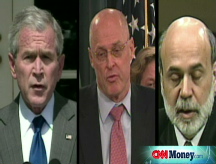Lending lockdown tightens grip
Treasurys rise again as credit markets remain tight, even after the $700 billion rescue bill passes the test in Senate.
 |
| The credit crisis affects your ability to get a loan, finance a home or even get paid. |
NEW YORK (CNNMoney.com) -- Credit remained hard to come by Thursday - even after the revised government bailout plan cleared the Senate - as investors waited to see if the bill can pass through the House.
The Senate on Wednesday night gave a stamp of approval to a financial rescue plan that was slightly changed from one rejected by the House just two days earlier.
The bill would allow the Treasury to buy up to $700 billion of troubled assets from financial institutions. Those assets, mostly mortgage-related, have caused the credit markets to seize up.
With loads of troubled assets on their balance sheets, banks are hesitant to take on more loans if the risk of default is high. Furthermore, when banks need to write down those assets, they have less cash on hand to issue loans. That stops the financial system's gears from turning, hurting customers who need a loan to finance a home, a car or tuition. Frozen cash flows also affects companies' ability to make payroll, which can result in layoffs.
The major aim of the government's bailout plan is to free up banks to start lending again once their balance sheets are cleared of toxic holdings.
But as the legislation faces a tough second vote Friday by the House, credit remains tight.
"The best we can hope for immediately if the bailout package is passed, is that it will stabilize confidence," said Scott Anderson, senior economist at Wells Fargo. "It's not a panacea for the near-term, as the package will not be helpful for three to six months down the road."
Market gauges: One indicator of how willing banks were to lend to other banks, called the "TED spread," showed high prices of loans between banks. The TED spread measures the difference between 3-month Libor and the 3-month Treasury borrowing rates and is a key indicator of risk. The higher the spread, the bigger the aversion to risk.
On Thursday, the spread surged to an intraday all-time high of 3.60% from Wednesday's close of 3.35%. By contrast, the TED spread was only 1.04% on Sept. 5.
Furthermore, the difference between the decade-old 3-month Libor and the Overnight Index Swaps rose to an all-time record 2.55%, up from 2.44% Wednesday, according to data reported by Bloomberg.com. It's the fifth-straight record for the measure, showing that banks are hoarding cash rather than lending to one another.
The Libor-OIS "spread" measures how much cash is available for lending between banks, and is used by banks to determine lending rates. The bigger the spread, the less cash is available for lending.
Historically, the typical Libor-OIS spread is about 0.11%, but it has averaged 1.66% since the crisis began on Wall Street mid-September, according to Merrill Lynch economist Drew Matus. In a recent note to clients, Matus said that a return to 1% would indicate the crisis has passed, but he does not believe the measure will return to 0.11% anytime before 2010.
"The bank failures have been keeping Libor spreads up, as banks continue to hoard cash," Anderson said. "They're very reluctant to lend to each other."
The Libor, or the London interbank offered rate, is a daily average of what banks charge other banks to lend money in London. Three-month Libor rose to 4.21% Thursday from 4.15% the day before. It's at its highest rate since Jan. 11.
Treasurys: Rather than invest in other financial institutions with risky assets on their balance sheets, banks and investors bought up government bonds. Treasurys are considered to be safer havens than stocks or commercial paper, as they are less volatile and guaranteed by the U.S. government.
The benchmark 10-year note rose 29/32 to 103 and its yield fell to 3.63% from 3.74% late Wednesday. Bond prices and yields move in opposite directions.
The yield on the 3-month bill - considered by many to be the safest investment - fell to 0.69% from 0.79% late Wednesday.
The 30-year bond rose 1-4/32 to 105-29/32 and its yield fell to 4.15% from 4.20%.
The 2-year note edged up 14/32 to 100-23/32 and its yield dipped to 1.62% from 1.82% Wednesday. ![]()



